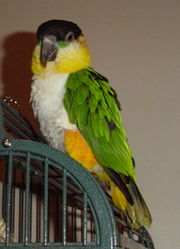| Caique | ||||||||||||
|---|---|---|---|---|---|---|---|---|---|---|---|---|
| Scientific classification | ||||||||||||
|
A Caique is one of two species of small, brightly colored parrot of the genus Pionites.
Caiques originate from the area of the Amazon Rainforest of northern Brazil and southern Venezuela, and the Guiana highlands.
In the wild, caiques generally prefer forested areas and subsist on fruit and seeds. Caiques are generally canopy dwellers, spending most of their time in the tops of trees, foraging and playing.
Caiques are also occasionally known as the "Seven-Color Parrot" because black, green, yellow, orange, white and blue feathers have all been observed. They have also been historically known as "The Dancing Parrot" for their habit of hopping and dancing, especially when encouraged by rhythmic clapping.
Contents |
Species
There are only two species of caique: the White-bellied Parrot or White-bellied Caique and the Black-headed Parrot or Black-headed Caique.

The White-Bellied Caique
The White-Bellied Caique, Pionites leucogaster, has an orange-yellow head, a white belly, green wings and back, bluish primary feathers, a horn-colored beak, and pink or grey feet. The white-belly tends to flock in pairs.
The Black-Headed Caique

The Black-Headed Caique, Pionites melanocephala, has a black crown, yellow to orange head, white belly, yellow leg feathers and underside of tail, green back and wings, bluish primaries, greyish bill, and black feet. Minor variations in this coloration exist. The black-head tends to flock in groups of about three dozen.
Aviculture
Caiques are growing in popularity in aviculture, the more commonly found species being the black-head. Caiques bond well with humans and have a reputation as playful birds, and enjoy playing with toys while laying on their backs. They are not particularly good flyers, instead preferring to walk, jump, or hop as a mode of transportation. Their behavior has been said to be most comparable to Lories and Lorikeets.
Caiques can be quiet (compared with the maximum volume of larger parrots) if trained properly. They have a peculiar call which has been compared to a smoke alarm, used for warning and for making contact with flock members who are out of visual range. This call is high, piercing, and loud enough to alert flock members across the jungle or neighboring apartment dwellers. They are extremely active, prefer lots of physical interaction and playtime, and are prolific chewers. They can be distrustful of or aggressive toward other species of parrot, so prospective buyers should be careful if they have or plan to have other types of parrots. They can also be highly demanding of human attention, and stubborn, not easily distracted from stealing eyeglasses or chewing unapproved items even when tempted with favorite treats and toys.
Caiques are poor imitators of human speech, and their appeal as a pet lies in their playfulness, not their speaking ability. They can learn to mimic words, and will speak in a soft and gravelly voice. They can also learn to whistle and some birds enjoy developing a large repertoire which they creatively recombine to come up with new calls and short tunes. They also enjoy learning environmental sounds such as telephone rings and microwave beeps.
Caiques have a particular odor. Some birds smell more strongly than others, and the scent can be described as a dry, cardboardlike smell. Prospective buyers should interact with a bird before buying it (as all pet buyers should) to see whether they find the smell unpleasant.
Sexing
As with most parrots, males and females of either species of caique look exactly the same. The only ways to determine sex are surgical sexing and DNA sexing.




 216.73.216.91
216.73.216.91 User Stats:
User Stats:
 Today: 0
Today: 0 Yesterday: 0
Yesterday: 0 This Month: 0
This Month: 0 This Year: 0
This Year: 0 Total Users: 117
Total Users: 117 New Members:
New Members:
 216.73.xxx.xx
216.73.xxx.xx
 Server Time:
Server Time: